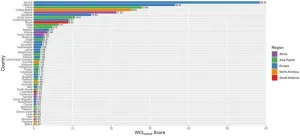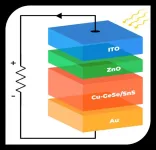(Press-News.org) A country’s economic prosperity is linked with improved well-being in its residents, according to a study published April 10, 2024 in the open-access journal PLOS ONE by Feng Huang from the Chinese Academy of Sciences, and colleagues.
Philosophers have long pondered the fraught relationship between money and happiness. Aristotle and Solon argued against the euphoric powers of wealth, while the Easterlin Paradox suggests that a nation’s economic fortitude can influence its residents’ health and happiness. Little evidence exists to support this claim in China, especially after the country’s recent economic expansion and rapid industrialization.
Huang and colleagues investigated the influence of national economic growth on subjective well-being (someone’s self-assessed level of happiness) across 31 provinces in mainland China from 2010-2020. To track economic health, the researchers used two data points from the National Bureau of Statistics of China: gross domestic product (GDP) per capita and the Gini coefficient, which reflects income inequality. To gauge the subjective well-being of Chinese residents, the researchers securely analyzed public content from 644,243 users of the microblogging platform Weibo. The researchers used natural language processing to analyze and quantify the tone of each post.
Results suggest that across all provinces from 2010-2020, subjective well-being increased alongside increased GDP per capita (by 0.38 units for every 46.70% increase in GDP per capita). Higher income inequality was associated with reduced subjective well-being (a reduction of 1.47 units for every 0.09 unit increase in the Gini coefficient), and when it becomes too high (i.e., when the Gini coefficient exceeds 0.609), the link between the economy and mental health no longer exists.
A majority of participants lived in the more affluent Eastern China, and all were literate social media users, which might affect the research’s generalizability to other populations. Further research could also interrogate wealth disparities within specific localities (as opposed to provinces). Nonetheless, the researchers state that their study "advocates for a balanced approach to economic planning" and they encourage adopting policies that combat income disparities and foster sustainable economic growth.
The authors add: “The equilibrium between economic growth and income equality is crucial for improving well-being in China, underscoring the nuanced interplay between prosperity and equitable wealth distribution for true happiness.”
#####
In your coverage please use this URL to provide access to the freely available article in PLOS ONE: https://journals.plos.org/plosone/article?id=10.1371/journal.pone.0301206
Citation: Huang F, Ding H, Han N, Li F, Zhu T (2024) Does wealth equate to happiness? an 11-year panel data analysis exploring socio-economic indicators and social media metrics. PLoS ONE 19(4): e0301206. https://doi.org/10.1371/journal.pone.0301206
Author Countries: China
Funding: Tingshao Zhu received the Scientific Foundation of Institute of Psychology, Chinese Academy of Sciences (No.E2CX4735YZ). The sponsor had no further role in study design, in the collection, nalysis and interpretation of data, in the writing of the report, and in the ecision to submit the paper for publication.
END
Economic wealth may be linked with happiness in China – if inequality is low
Data spanning eleven years indicate that well-being rises with economic growth but falls when income inequality increases
2024-04-10
ELSE PRESS RELEASES FROM THIS DATE:
Most cybercriminal threats are concentrated in just a few countries
2024-04-10
A newly developed World Cybercrime Index shows that most cybercriminal threats are concentrated in several countries, with different countries associated with distinct cybercrime types. Miranda Bruce (University of Oxford/University of New South Wales), Jonathan Lusthaus (University of Oxford), Ridhi Kashyap (University of Oxford), Nigel Phair (Monash University), and Federico Varese (Sciences Po) present these findings in the open-access journal PLOS ONE on April 10, 2024.
Worldwide, cybercrimes are estimated to cost hundreds ...
US building footprints could help identify neighborhood sociodemographic traits
2024-04-10
An analysis of building footprints in major US metropolitan areas identifies five different neighborhood types that vary in footprint size, shape, and placement, and which are statistically associated with varying neighborhood socioeconomic and demographic traits. Noah Durst of Michigan State University, US, and colleagues present these findings in the open-access journal PLOS ONE on April 10, 2024.
People have long studied the shape and placement of human settlements—“neighborhood morphology”—to help inform urban planning and management. Recent technological advancements, such as high-resolution satellite imagery and more powerful computational ...
Indigenous Australian message sticks, which feature markings to convey messages over long distances, analyzed for first time at scale through new database of 1,500 artifacts
2024-04-10
Indigenous Australian message sticks, which feature markings to convey messages over long distances, analyzed for first time at scale through new database of 1,500 artifacts
###
Article URL: https://journals.plos.org/plosone/article?id=10.1371/journal.pone.0299712
Article Title: AMSD: The Australian Message Stick Database
Author Countries: Australia, Germany
Funding: The lead author (Piers Kelly) receives salary and project funding specifically for the research described in this paper. He is funded by an ARC Discovery Early Career Researcher ...
Mixed diets balance nutrition and carbon footprint
2024-04-10
What we eat can impact our health as well as the environment. Many studies have looked at the impacts of diets in very general terms focused at the level of food groups. A new study led by researchers at the University of Tokyo explores this issue following a more nuanced dish-level approach. One of the benefits of this kind of study is that people’s connections with their diets vary around the world and have strong cultural associations. Knowledge of the impacts of diets using dishes rather than broad food groups can help individuals make informed choices and those in the food industry improve ...
New quantum material promises over 190% quantum efficiency in solar cells
2024-04-10
Researchers from Lehigh University have developed a material that demonstrates the potential for drastically increasing the efficiency of solar panels.
A prototype using the material as the active layer in a solar cell exhibits an average photovoltaic absorption of 80%, a high generation rate of photoexcited carriers, and an external quantum efficiency (EQE) up to an unprecedented 190%—a measure that far exceeds the theoretical Shockley-Queisser efficiency limit for silicon-based materials and pushes the field of quantum materials for photovoltaics to ...
AI powered “digital twin” models the infant microbiome
2024-04-10
The gut microbiome has a profound impact on the health and development of infants. Research shows that dysbiosis—or imbalances in the microbial community—is associated with gastrointestinal diseases and neurodevelopmental deficits. Understanding how gut bacteria interact, and how these interactions may lead to some of these problems, however, is difficult and time consuming through traditional laboratory experiments.
Researchers at the University of Chicago have developed a new generative artificial intelligence (AI) tool that models the infant microbiome. This “digital ...
World-first “Cybercrime Index” ranks countries by cybercrime threat level
2024-04-10
Following three years of intensive research, an international team of researchers have compiled the first ever ‘World Cybercrime Index’, which identifies the globe’s key cybercrime hotspots by ranking the most significant sources of cybercrime at a national level.
The Index, published today in the journal PLOS ONE, shows that a relatively small number of countries house the greatest cybercriminal threat. Russia tops the list, followed by Ukraine, China, the USA, Nigeria, and Romania. The UK comes in at number eight.
Co-author of the study, Dr Miranda Bruce from the ...
A study in Science Advances suggests liquid biopsy could detect and monitor aggressive small cell lung cancer
2024-04-10
A new lab assay developed by researchers at Fred Hutch Cancer Center could make diagnosis and treatment of small-cell lung cancer and non-small cell lung cancer easier.
The blood-based test, also called a “liquid biopsy,” can detect differences between types of lung cancer by examining patterns in cell-free tumor DNA in blood samples. It’s a desirable option for detecting small-cell lung cancer (SCLC) as standard needle biopsies fail due the number of smaller tumors typically present and the variety of tumor subtypes that indicate different treatment pathways.
“There ...
New drug prevents flu-related inflammation and lung damage
2024-04-10
(MEMPHIS, Tenn. – April 10, 2024) Infection with the influenza virus leads to lung injury through inflammation over-activation that causes collateral damage to cells required for breathing. Such damage can be life-threatening, but scientists have a new preventative treatment. A team from St. Jude Children’s Research Hospital, University of Houston, Tufts University School of Medicine and Fox Chase Cancer Center created a drug that can prevent flu-induced lung injury. In a mouse model, the ...
Taking on the global challenge of hidden hunger
2024-04-10
COLUMBIA, Mo. — More than 2 billion people suffer from hidden hunger, a form of malnutrition where individuals lack essential micronutrients — like vitamins and minerals — even though they consume what appears to be an adequate amount of calories.
University of Missouri researcher Kiruba Krishnaswamy is focused on tackling this global challenge. She recently received a five-year, $532,000 Early Career Development (CAREER) award from the National Science Foundation (NSF) — the NSF’s most prestigious award for early-career faculty — in support of her project titled ...
LAST 30 PRESS RELEASES:
The (metabolic) cost of life
CFRI special issue call for papers: New Frontiers in Sustainable Finance
HKU Engineering scholar demonstrates the smallest all-printed infrared photodetectors to date
Precision empowerment for brain "eavesdropping": CAS team develops triple-electrode integrated functional electrode for simultaneous monitoring of neural signals and chemical transmitters during sleep
Single-capillary endothelial dysfunction resolved by optoacoustic mesoscopy
HKU three research projects named among ‘Top 10 Innovation & Technology News in Hong Kong 2025’ showcasing excellence in research and technology transfer
NLRSeek: A reannotation-based pipeline for mining missing NLR genes in sequenced genomes
A strand and whole genome duplication–aware collinear gene identification tool
Light storage in light cages: A revolutionary approach to on-chip quantum memories
Point spread function decoupling in computational fluorescence microscopy
BacPhase: Long-insert paired-end sequencing for bin marker construction and genome phasing
GmWOX1 regulates the mediolateral polarity of compound leaves in soybean
ChargeFabrica: An open-source simulation tool that aims to accelerate search for high performance perovskite solar cells
High levels of ADAR overexpression induce abundant and stochastic off-target RNA editing in rice protoplasts
On-demand upgraded recycling of polyethylene and construction of sustainable multifunctional materials based on the "LEGO" strategy
New "Stomata in-sight" system allows scientists to watch plants breathe in real-time
Anorexia nervosa may result in long-term skeletal muscle impairment
Narrative-based performance reviews deemed fairest by employees
New insights reveal how advanced oxidation can tackle emerging water pollutants
New review shows how biomass can deliver low-carbon gaseous fuels at scale
Climate change is quietly rewriting the world’s nitrogen cycle, with high stakes for food and the environment
Study finds SGLT-2 inhibitors linked to lower risk of diabetic foot nerve damage
Microbes may hold the key to brain evolution
Study examines how the last two respiratory pandemics rapidly spread through cities
Gender stereotypes reflect the division of labor between women and men across nations
Orthopedics can play critical role in identifying intimate partner violence
Worms as particle sweepers
Second spider-parasitic mite described in Brazil
January 2026 issues of APA journals feature new research on autism, pediatric anxiety, psychedelic therapy, suicide prevention and more
Private equity acquired more than 500 autism centers over the past decade, new study shows
[Press-News.org] Economic wealth may be linked with happiness in China – if inequality is lowData spanning eleven years indicate that well-being rises with economic growth but falls when income inequality increases









